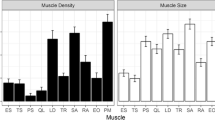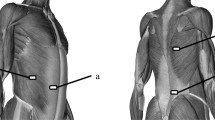Abstract
The purpose of this study was to examine the age-related site-specific muscle loss of the upper and lower extremities and trunk in men and women. Japanese nonobese adults aged 20–79 (n = 1559, 52 % women) had muscle thickness (MTH) measured by ultrasound at nine sites on the anterior and posterior aspects of the body. An MTH ratio located in the anterior and posterior aspects of the upper arm, upper leg, lower leg, and trunk was calculated. Site-specific muscle loss was defined as a ratio of MTH > 2 standard deviations below the mean for young adults in each segment. Age was inversely correlated (p < 0.001) to upper-leg MTH ratio in men (r = −0.463) and women (r = −0.541). Age was correlated positively to upper-arm MTH ratio and inversely to trunk MTH ratio in men (r = 0.191 and r = −0.238, both p < 0.001) and women (r = 0.102, p = 0.004 and r = −0.446, p < 0.001). Weak correlations were observed between age and lower-leg MTH ratios in men (r = 0.015, p = 0.682) and women (r = 0.086, p = 0.015). The prevalence of site-specific upper-leg muscle loss showed an age-related increasing pattern in men (6 % for ages 30–39, 21 % for ages 50–59, and 38 % for ages 70–79) and women (15 % for ages 30–39, 32 % for ages 50–59, and 50 % for ages 70–79). For other segments, however, the prevalence rate of site-specific muscle loss was relatively low throughout the age groups in men and women, although higher rates were observed in the older group. These results suggest that the anterior/posterior MTH ratio of the upper leg may be useful in providing an earlier diagnosis for site-specific muscle loss.
Similar content being viewed by others
References
Aagaard P, Suetta C, Caserotti P, Magnusson SP, Kjaer M (2010) Role of the nervous system in sarcopenia and muscle atrophy with aging: strength training as a countermeasure. Scand J Med Sci Sports 20:49–64
Abe T, Kondo M, Kawakami Y, Fukunaga T (1994) Prediction equations for body composition of Japanese adults by B-mode ultrasound. Am J Hum Biol 6:161–170
Abe T, Sakamaki M, Yasuda T, Bemben MG, Kondo M, Kawakami Y, Fukunaga T (2011a) Age-related, site-specific muscle loss in 1507 Japanese men and women aged 20 to 95 years. J Sports Sci Med 10:145–150
Abe T, Kawakami Y, Kondo M, Fukunaga T (2011b) Comparison of ultrasound-measured age-related, site-specific muscle loss between healthy Japanese and German men. Clin Physiol Funct Imaging 31:320–325
Abe T, Ogawa M, Loenneke JP, Thiebaud RS, Loftin M, Mitsukawa N (2012a) Relationship between site-specific loss of thigh muscle and gait performance in women: the HIREGASAKI study. Arch Gerontol Geriatr 55:e21–e25
Abe T, Thiebaud RS, Loenneke JP, Loftin M, Bemben MG, Fukunaga T (2012b) Influence of severe sarcopenia on cardiovascular risk factors in nonobese men. Metab Syndr Relat Disord 10:407–412
Abe T, Ogawa M, Loenneke JP, Thiebaud RS, Loftin M, Mitsukawa N (2013a) Association between site-specific muscle loss of lower body and one-leg standing balance in active women: the HIREGASAKI study. Geriatr Gerontol Int, doi:10.1111/ggi.12112, published online: 07.07.2013
Abe T, Thiebaud RS, Loenneke JP, Loftin M, Fukunaga T (2013b) Prevalence of site-specific thigh sarcopenia in Japanese men and women. Age (Dordr), doi:10.1007/s11357-013-9539-6, published online: 18.05.2013
Abe T, Dabbs NC, Nahar VK, Ford MA, Bass MA, Loftin M (2013c) Relationship between dual-energy X-ray absorptiometry-derived appendicular lean tissue mass and total body skeletal muscle mass estimated by ultrasound. Int J Clin Med 4:283–286
Baumgartner RN, Koehler KM, Gallagher D, Romero L, Heymsfield SB, Ross R, Garry PJ, Linderman RD (1998) Epidemiology of sarcopenia among the elderly in New Mexico. Am J Epidemiol 147:755–763
Beyer I, Mets T, Bautmans I (2012) Chronic low-grade inflammation and age-related sarcopenia. Curr Opin Clin Nutr Matab Care 15:12–22
Bijlsma AY, Meskers CGM, Ling CH, Narici M, Kurrle SE, Cameron ID, Westendrorp RG, Maier AB (2013) Defining sarcopenia: the impact of different diagnostic criteria on the prevalence of sarcopenia in a large middle aged cohort. Age (Dordr) 35:871–881
Brozek J, Grande F, Anderson JT, Keys A (1963) Densitometric analysis of body composition: revision of some quantitative assumptions. Ann N Y Acad Sci 110:113–140
Bunout D, de la Maza MP, Barrera G, Leiva L, Hirsch S (2011) Association between sarcopenia and mortality in healthy older people. Australas J Aging 30:89–92
Burns JM, Johnson DK, Wa0s A, Swerdlow RH, Brooks WM (2010) Reduced lean mass in early Alzheimer disease and its association with brain atrophy. Arch Neurol 67:428–433
Frontera WR, Reid KF, Phillips EM, Krivickas LS, Hughes VA, Roubenoff R, Fielding RA (2008) Muscle fiber size and function in elderly humans: a longitudinal study. J Appl Physiol 105:637–642
Janssen I (2010) Evolution of sarcopenia research. Appl Physiol Nutr Metab 35:707–712
Janssen I, Heymsfield SB, Ross R (2002) Low relative skeletal muscle mass (sarcopenia) in older persons is associated with functional impairment and physical disability. J Am Getriatr Soc 50:889–896
Klein CS, Peterson LB, Ferrell S, Thomas CK (2010) Sensitivity of 24-h EMG duration and intensity in the human vastus lateralis muscle to threshold changes. J Appl Physiol 108:655–661
Mitchell WK, Williams J, Atherton P, Larvin M, Lund J, Narici M (2012) Sarcopenia, dynapenia, and the impact of advancing age on human skeletal muscle size and strength; a quantitative review. Front Physiol 3:260
Newman AB, Kupelian V (2003) Sarcopenia: alternative definitions and associations with lower extremity function. J Am Geriatr Soc 51:1602–1609
Ogawa M, Yasuda T, Abe T (2012a) Component characteristics of thigh muscle volume in young and older healthy men. Clin Physiol Funct Imaging 32:89–93
Ogawa M, Mitsukawa N, Loftin M, Abe T (2012b) Association of vigorous physical activity with age-related, site-specific loss of thigh muscle in women: the HIREGASAKI study. J Trainol 1:6–9
Park SW, Goodpaster BH, Lee JS, Kuller L, Boudreau R, De Rekeneire N, Harris TB, Kritchevsky S, Tylavsky FA, Nevitt M, Cho YW, Newman AB, Health, Aging, and Body Composition Study (2009) Excessive loss of skeletal muscle mass in older adults with type 2 diabetes. Diabetes Care 32:1993–1997
Power GA, Dalton BH, Behm DG, Doherty TJ, Vandervoort AA, Rice CL (2012) Motor unit survival in lifelong runners is muscle dependent. Med Sci Sports Exerc 44:1235–1242
Rosenberg IH (1997) Sarcopenia: origins and clinical relevance. J Nutr 127:990S–991S
Ryall JG, Schertzer JD, Lynch GS (2008) Cellular and molecular mechanisms underlying age-related skeletal muscle wasting and weakness. Biogerontol 9:213–228
Saeterbakken AH, Fimland MS (2012) Muscle activity of the core during bilateral, unilateral, seated and standing resistance exercise. Eur J Appl Physiol 112:1671–1678
Sanada K, Kearns CF, Midorikawa T, Abe T (2006) Prediction and validation of total and regional skeletal muscle mass by ultrasound in Japanese adults. Eur J Appl Physiol 96:24–31
Sawai S, Sanematsu H, Kanehisa H, Tsunoda N, Fukunaga T (2006) Sexual-related difference in the level of muscular activity of trunk and lower limb during basic daily life actions. Jap J Phys Fitness Sports Med 55:247–258
Shirasawa H, Kanehisa H, Kouzaki M, Masani K, Fukunaga T (2009) Differences among lower leg muscles in long-term activity during ambulatory condition without any moderate to high intensity exercise. J Electromyogr Kinesiol 19:e50–e56
Tikkanen O, Haakana P, Pesola AJ, Hakkinen K, Rantalainen T, Havu M, Pullinen T, Finni T (2013) Muscle activity and inactivity periods during normal daily life. PLoS One 8:e52228
WHO (2000) Obesity: preventing and managing the global epidemic. Report of a WHO Consultation. WHO Technical Report Series 894, Geneva, Switzerland
Author information
Authors and Affiliations
Corresponding author
About this article
Cite this article
Abe, T., Loenneke, J.P., Thiebaud, R.S. et al. Age-related site-specific muscle wasting of upper and lower extremities and trunk in Japanese men and women. AGE 36, 813–821 (2014). https://doi.org/10.1007/s11357-013-9600-5
Received:
Accepted:
Published:
Issue Date:
DOI: https://doi.org/10.1007/s11357-013-9600-5




